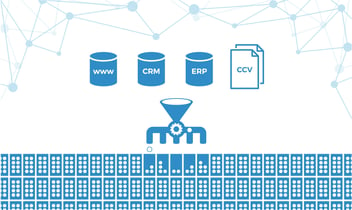Find out how data warehouse automation can streamline data computing tasks and what are the benefits of ETL in the cloud!
Data warehouse automation is a next-generation technology that relies on advanced design patterns and processes to automate the planning, modeling, and integration steps of the entire data warehouse lifecycle. Automation provides an efficient alternative to traditional data warehouse design because it reduces time-consuming tasks such as generating and implementing ETL code on a database server.

Differences between a data warehouse and other databases
A data warehouse (DWH) is a type of database that includes certain advantages over other databases. Designed to store, filter and facilitate data analysis, this tool allows companies to work with large amounts of data and to visualize and analyze information simultaneously and cross-referentially, without having to mix and consolidate results from different data sources.
In addition, a data warehouse can be connected to business intelligence tools such as Power BI, which facilitates quick access to data through business intelligence tools, SQL, Azure Analysis Services and other analysis applications. On the other hand, a data warehouse can streamline data processing activities, as it facilitates the elimination of errors, duplicate data and inaccurate or uninteresting information. This, in turn, promotes data quality, data governance and the consolidation of the data.
Data warehouse automation: step by step
In traditional data warehouses, data goes through three phases:
- Relational database (OLTP): In this stage, SQL scripts are used to extract all transactional data from relational databases. Before moving the data, it is cleaned to verify the consistency of wrong and inaccurate information. At this stage, all data is based on an entity-relationship model and is used for online transactional processing.
- Analytical data warehouse (OLAP): Transactional data is modeled in star or snowflake schemas and transferred to an online analytical processing or OLAP server via an OLAP or multidimensional relational data model. This structures and simplifies the data for analytical reporting and queries. The data is then transformed and loaded into the data warehouse.
- Analysis and reporting: Once the ETL processes are completed, the data from the data warehouse is exported to business intelligence and analytics tools to provide information for decision making.
A data warehouse automation software provides a seamless, no-code approach that makes it possible to aggregate and move disparate business data from source systems to a data warehouse and beyond. Unlike traditional data warehouses, this software automates the batch execution and ETL code deployment requirements of the data warehouse process. Built on agile methodologies, the automation software allows a variety of possibilities including:
- Denormalized, normalized and multidimensional data structures.
- ETL and ELT data integration processes.
- Source data modeling.
- Connectivity with multiple data providers.
ETL as a part of data warehouse
The ETL process is what unlocks the value of the data warehouse. While the data warehouse acts as the storage place for all the data, and the BI tools serve as the mechanism that exploits the data to provide insights, the ETL is the middleman that pushes all the data and customer tools into the data warehouse for its analysis. The ETL phase is where the business will spend a good portion of its time and energy in developing a data warehouse solution.
ETL in the cloud
ETL in the cloud involves extracting data from all the source systems, transforming it into a common format and loading the consolidated data into the data warehousing platform to better meet business intelligence, reporting and analytics needs. Working in the cloud offers a variety of benefits, such as real-time streaming or fast integrations. It is also the best option if your data warehouse is in the cloud.
In a previous post in this blog, we already talked about the benefits of cloud integration, which, among other things, saves money, facilitates integration and scalability and improves data security.
Advantages and disadvantages of ETL in the cloud
The transition from ETL in on-premises origins to cloud environments has been a transformative process linked to the evolving speed and capabilities of the Internet. A study made by IDG announced in 2018 that 73% of companies had part of their infrastructure stored in the cloud and the 38% of the organizations surveyed admitted that their IT departments felt pressure to carry out full cloud integration.
This way, the most outstanding and valued advantage of ETL in the cloud is the increased speed. The cloud environment means that the computational tasks of an ETL process are carried out much more quickly, as well as it optimizes business intelligence activities that, in the local environment, can get stuck due to the constant growth of the volume of data with which companies work and the speed of this growth. In addition, the implementation of cloud ETL processes is generally fast, as the cloud ETL environment can be easily connected to both on-premises and cloud services.
On top of that, the cloud environment means greater flexibility over on-premises environments and allows organizations to pay by the hour if they contract an ETL SaaS tool.
In short, data warehouse automation is a cutting-edge technology that greatly speeds up data integration, automates time-consuming processes and tasks, and ensures the interoperability of all enterprise systems in a cloud environment that optimizes business intelligence operations.



